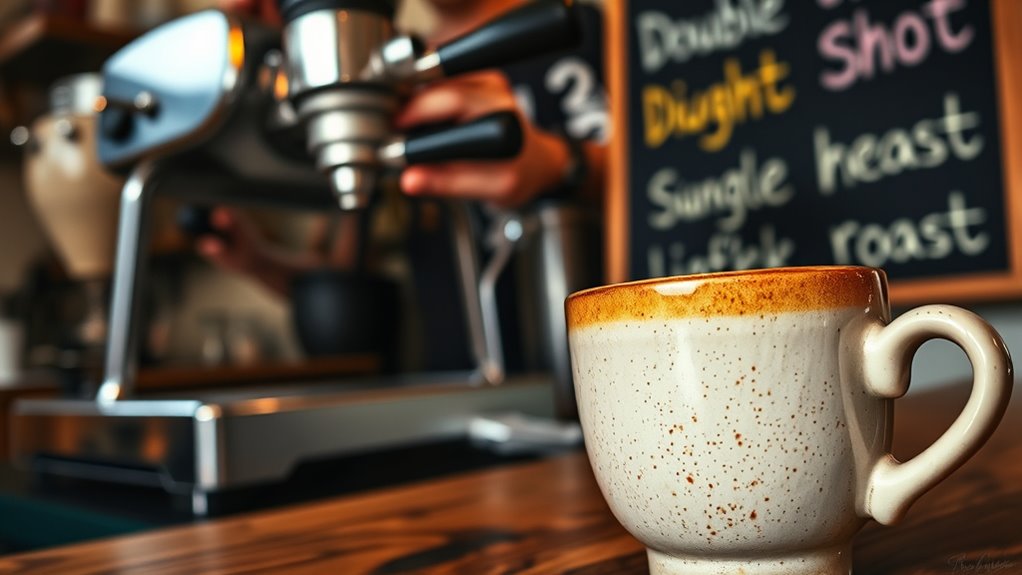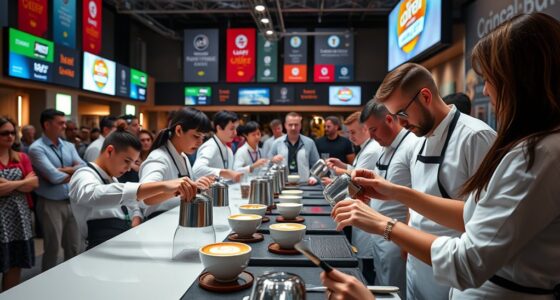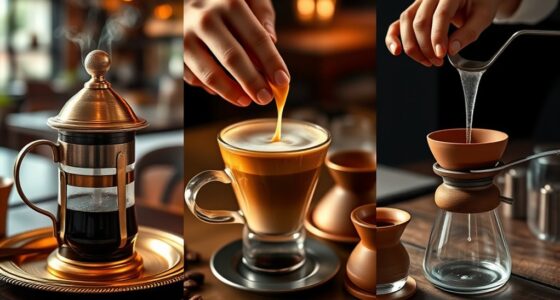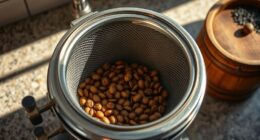Getting familiar with café slang and brew terms helps you communicate confidently with baristas and understand your coffee better. Knowing phrases like “double shot,” “pulled shot,” or “skinny latte” allows you to customize drinks and appreciate the craft behind each one. Recognizing espresso art and brewing techniques signals quality and skill. With a grasp of these terms, you’ll enjoy your coffee experience more—stick around to discover even more tips that reveal the true depth of coffee culture.
Key Takeaways
- Familiarize yourself with common café terms like “double shot,” “single origin,” and “pulled shot” to understand brewing methods.
- Learn how to identify and request coffee modifications such as “skinny latte” or “extra shot” for personalized drinks.
- Recognize espresso art designs like hearts and rosettas as signs of barista skill and drink quality.
- Use café slang confidently to streamline ordering and communicate preferences clearly with baristas.
- Appreciating coffee terminology enhances your overall experience and connection within the coffee community.
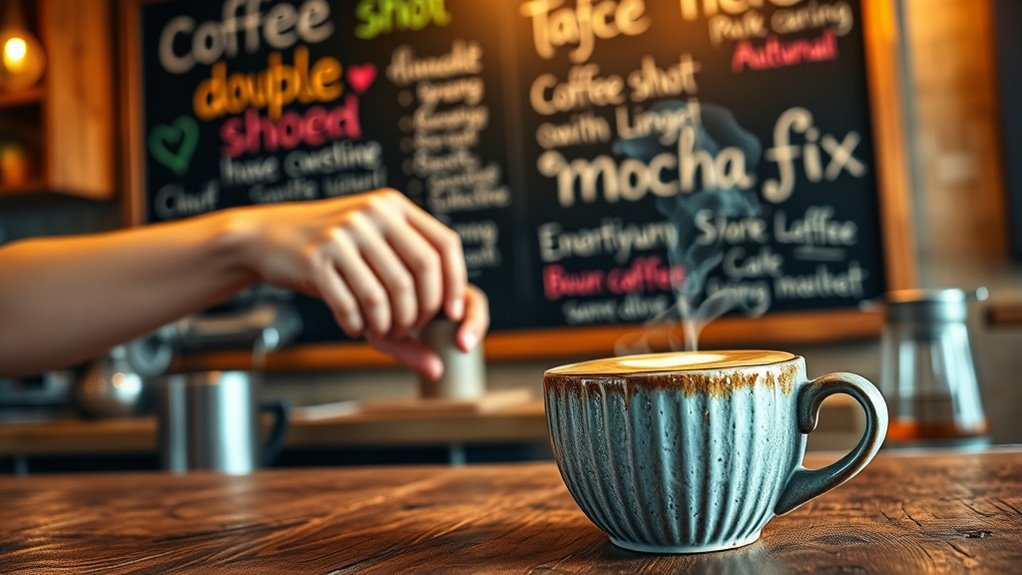
Ever wondered what baristas and coffee enthusiasts mean when they toss around terms like “double shot” or “skinny latte“? Coffee culture is rich with slang and specialized language that can feel overwhelming at first glance. But once you understand some basic café lingo, you’ll navigate menus and conversations with confidence. One of the most visually striking elements you’ll encounter is espresso art—those intricate designs crafted atop a well-pulled shot of espresso. Espresso art isn’t just about aesthetics; it’s a sign of skill, precision, and proper brew techniques. When baristas pour steamed milk over espresso, they manipulate the flow and angle to create patterns like hearts, rosettas, or tulips. This art adds a personal touch to your coffee experience and signals a barista’s mastery of brew terminology and technique.
Espresso art showcases skill, precision, and mastery through beautiful patterns atop your coffee.
Brew terminology is a key part of understanding coffee conversations. It refers to the specific language used to describe different brewing methods, grind sizes, and extraction times. For instance, a “double shot” means pulling two shots of espresso, which is often the base for many espresso-based drinks like lattes and cappuccinos. Knowing this helps you customize your drink—whether you want a single shot or a double. Similarly, a “single origin” refers to coffee beans sourced from a specific region, emphasizing unique flavors that vary depending on location. Baristas might ask if you prefer a “pulled shot” or a “manual brew,” both terms indicating the method used to extract your coffee. These terms help you understand what’s happening behind the scenes and allow you to request exactly what you want. Additionally, understanding the concept of narcissistic traits can help you recognize when someone’s passion for their craft turns into excessive self-focus, which is common among individuals with narcissistic tendencies.
Understanding café slang also involves recognizing how baristas describe different drink modifications. For example, asking for a “skinny latte” means requesting a latte made with skim milk, reducing fat content. If you hear someone ask for a “pour-over,” they’re referring to a manual brewing method where hot water is poured over coffee grounds in a filter. This method highlights brew terminology, explaining specific steps and equipment involved. As you learn these terms, you’ll start noticing how conversations flow more easily, and you’ll be more confident ordering or even trying to make your own coffee at home.
In essence, mastering café slang and brew terminology transforms your coffee experience from confusing to enjoyable. It connects you to a community of enthusiasts and baristas who take pride in their craft. Whether it’s appreciating espresso art or understanding the nuances of different brewing techniques, these terms empower you to engage more deeply with your favorite beverage. So next time you’re in a café, listen closely and start picking up on these words—you’ll find that speaking coffee is an art in itself.
Frequently Asked Questions
How Do I Politely Ask for a Decaf Coffee?
When you want a decaf coffee, you should follow proper customer and ordering etiquette. Politely ask the barista, “Could I please have a decaf coffee?” or “I’d like a decaf, please.” Using courteous language shows respect and makes the process smooth. Remember to make eye contact, smile, and say thank you afterward. This simple approach guarantees you’re respectful while clearly communicating your preference.
What Does “Single Shot” Mean in Café Terminology?
They say “a picture’s worth a thousand words,” but in coffee, a single shot tells a story. A “single shot” means one espresso shot or coffee shot, typically about 1 ounce of strong, concentrated coffee. It’s the foundation for many drinks, providing a rich flavor without being too intense. When ordering, just ask for a “single shot” if you want one, and baristas will know exactly what you mean.
How Can I Identify Specialty Coffee Terms?
To identify specialty coffee terms, start by exploring common phrases related to coffee flavor profiles and brewing equipment terminology. Pay attention to descriptors like fruity, floral, or acidic, which describe flavor notes. Also, learn terms like pour-over, AeroPress, or Chemex, which refer to brewing methods. Reading coffee blogs, labels, or asking baristas can help you familiarize yourself with these specialized words and deepen your coffee knowledge.
Are There Regional Differences in Café Slang?
Imagine strolling into a cozy café where locals speak a secret code of regional slang variations. You notice dialectal coffee terms that differ from place to place, giving each spot its own flavor. Yes, regional differences in café slang do exist, making conversations richer and more colorful. You’ll find that understanding these dialectal coffee terms helps you connect better and feel more at home, no matter where you’re sipping your brew.
What’S the Difference Between “Brew” and “Pour-Over”?
You might wonder about coffee terminology like “brew” and “pour-over.” A “brew” is a general term for any method of making coffee, while “pour-over” is a specific brewing technique where hot water is poured over coffee grounds in a filter. As a barista, you’ll hear these terms used to describe different styles. Understanding this jargon helps you communicate clearly and appreciate the nuances of café lingo.
Conclusion
Now that you’re familiar with café slang and lingo, you’ll feel more confident chatting with baristas and fellow coffee lovers. Remember, “a little knowledge goes a long way,” and using these terms can make your café visits more fun and engaging. So next time you order, don’t be shy—speak the language, enjoy your brew, and embrace the vibrant coffee community around you. Cheers to many more flavorful conversations!
